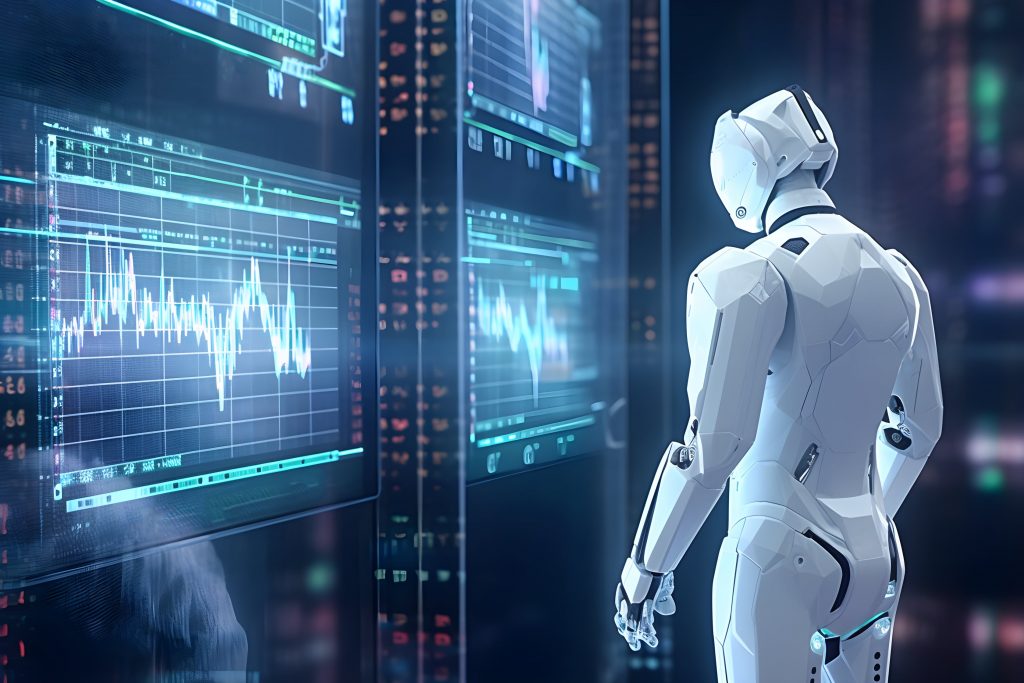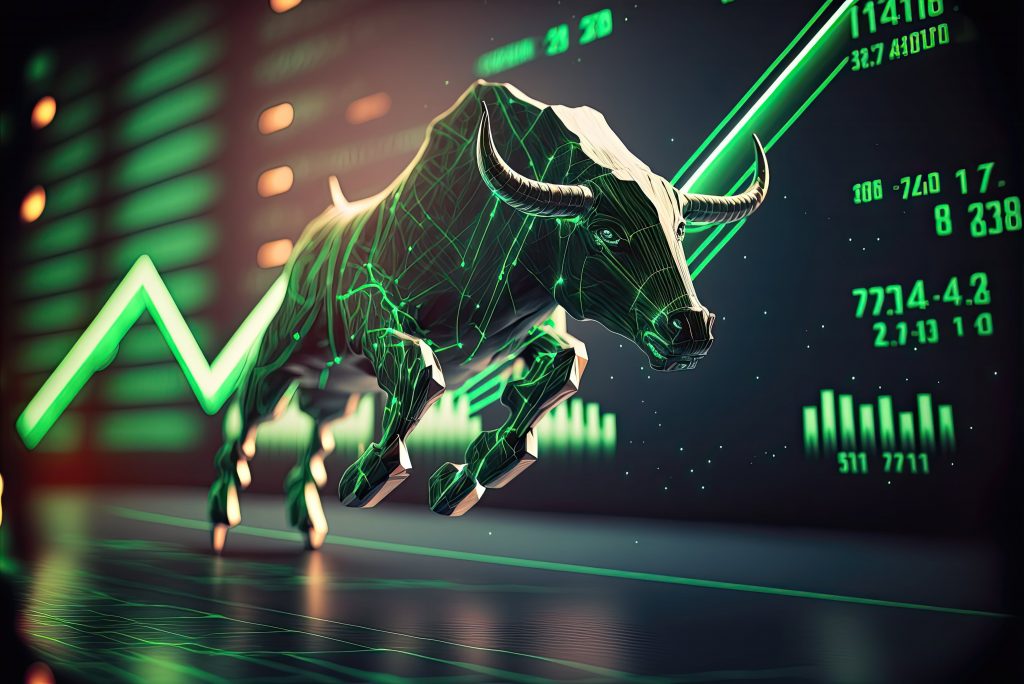In today's fast-paced financial markets, a new player has emerged, one that does not sleep, make emotional decisions, or require a paycheck. Artificial Intelligence (AI) and robot trading have taken the financial world by storm, revolutionising how investors approach trading. Gone are the days of relying solely on human expertise and gut instincts.
With the rise of AI, algorithms and machine learning have become the driving force behind market predictions and investment strategies. This shift in the financial landscape has not only opened up new opportunities for traders but has also raised questions about the future of traditional trading practices.
In this article, we will explore the exciting world of robot trading and delve into how AI is reshaping the way we trade, the impact it has on market volatility, and the potential risks and benefits for traders. So, sit back, relax, and let's dive into the fascinating realm of AI-driven financial markets.
The History and Evolution of Robot Trading
Robot trading, also known as algorithmic trading or automated trading, has a rich history that dates back to the 1970s. Initially, it was primarily used by large financial institutions with access to advanced technology and powerful computers. However, with technological advancements and the increasing availability of data, robot trading has become more accessible to individual traders.
The early days of robot trading were marked by simple rule-based algorithms that executed trades based on predefined conditions. These algorithms were limited in their capabilities and were often prone to errors. However, as technology improved, so did the sophistication of these algorithms.
In recent years, the introduction of AI and machine learning has taken robot trading to new heights. AI-powered algorithms can analyse vast amounts of data, identify patterns, and make predictions with a high degree of accuracy. This has transformed the way trading strategies are developed and executed, allowing traders to leverage the power of AI to gain an edge in the markets.

With the evolution of robot trading, traders can now automate their trading strategies, execute trades at lightning-fast speeds, and take advantage of market opportunities that would be impossible to spot manually. This has led to increased efficiency and reduced costs for traders, as well as improved liquidity in the financial markets.
Benefits of Using AI in Financial Markets
The integration of AI in financial markets brings a multitude of benefits for traders. One of the key advantages is the ability to process and analyse vast amounts of data in real time. AI algorithms can sift through mountains of financial data, news articles, social media posts, and other relevant information to identify patterns and make informed trading decisions.
This level of data analysis would be humanly impossible, giving AI-powered systems a significant advantage in spotting opportunities and mitigating risks.
Another benefit of AI in financial markets is the elimination of human emotions and biases. Unlike humans, AI algorithms do not experience fear, greed, or other emotions that can cloud judgment. This allows for more rational decision-making and reduces the potential for costly mistakes.
AI-powered trading systems can also operate 24/7 without the need for breaks or sleep. This ensures that no trading opportunities are missed, as the algorithms can continuously monitor the markets and execute trades when favourable conditions arise. This round-the-clock trading capability can give traders a competitive edge in capturing market movements and generating profits.
Furthermore, AI algorithms can adapt and learn from market conditions. Machine learning techniques enable these algorithms to improve their performance over time by continuously analysing past trades and refining their strategies. This adaptive nature of AI allows traders to stay ahead of changing market dynamics and adjust their trading strategies accordingly.
In summary, the benefits of using AI in financial markets are numerous. From enhanced data analysis and decision-making to round-the-clock trading and adaptive strategies, AI-powered systems offer traders a powerful tool to navigate the complexities of modern financial markets.
Impact of AI on Traditional Trading Strategies
The rise of AI in financial markets has had a profound impact on traditional trading strategies. Gone are the days when traders relied solely on fundamental analysis or technical indicators to make trading decisions. With AI, new types of trading strategies have emerged that leverage the power of machine learning and data analysis.

One major impact of AI on traditional trading strategies is the shift from discretionary trading to systematic trading. Discretionary traders rely on their subjective judgment and intuition to make trading decisions. However, AI-powered systems use objective data analysis to drive trading decisions, removing the human element from the equation. This shift has led to increased efficiency and consistency in trading strategies.
Another impact of AI on traditional trading strategies is the increased focus on quantitative analysis. AI algorithms can analyse vast amounts of data and identify complex patterns that may not be apparent to human traders.
Development of Strategies
This has led to the development of quantitative trading strategies that rely on statistical models and mathematical algorithms to generate trading signals. These strategies can be backtested and optimised to maximise returns and minimise risks.
Furthermore, AI has also impacted the speed and execution of trades. High-frequency trading (HFT) has become increasingly prevalent, with AI algorithms executing trades in microseconds. This has led to a more competitive and fast-paced trading environment, where milliseconds can make a significant difference in profitability.
However, it is important to note that while AI has brought many benefits to trading strategies, it is not a magic bullet. It is still essential for traders to understand the underlying principles and risks associated with the strategies they employ. AI algorithms are not infallible and can be subject to biases or errors if not properly calibrated or monitored.
In conclusion, AI has disrupted traditional trading strategies by introducing new approaches, and increased efficiency, and speed. Traders now have access to powerful tools that can analyse vast amounts of data, identify patterns, and execute trades with precision. However, it is crucial for traders to understand the limitations and risks associated with AI-driven trading and to use these tools as part of a well-rounded trading strategy.
Read More: What Is EA Trading?
Common Types of AI Used in Robot Trading
In the world of robot trading, various types of AI techniques are employed to analyse data, generate trading signals, and execute trades. Here are some of the most common types of AI used in robot trading:
1. Machine Learning
Machine learning is a subset of AI that involves training algorithms to learn from data and make predictions or decisions without being explicitly programmed. Its algorithms can analyse historical market data to identify patterns and generate trading signals. These algorithms can be trained to adapt and improve their performance over time.
2. Deep Learning
Deep learning is a type of machine learning that uses artificial neural networks to model and understand complex patterns in data. Its algorithms can analyse large datasets and extract meaningful features to make predictions or decisions. In robot trading, deep learning algorithms can be used to analyse market data, news articles, social media sentiment, and other relevant information to generate trading signals.
3. Natural Language Processing (NLP)
NLP is a branch of AI that focuses on the interaction between computers and human language. NLP algorithms can analyse written or spoken language to extract meaning and sentiment. In robot trading, NLP algorithms can be used to analyse news articles, earnings reports, and social media posts to gauge market sentiment and make informed trading decisions.
4. Reinforcement Learning
Reinforcement learning is a type of machine learning that involves training algorithms through trial and error. Its algorithms can learn from their actions and adjust their behaviour to maximise rewards. In robot trading, reinforcement learning algorithms can be used to optimise trading strategies by continuously adapting to changing market conditions.
5. Genetic Algorithms
Genetic algorithms are a type of optimisation algorithm inspired by the process of natural selection. This can be used to evolve trading strategies by generating a population of candidate solutions and iteratively improving them over generations. In robot trading, genetic algorithms can optimise trading strategies by selecting the best-performing ones based on predefined fitness criteria.
These are just a few examples of the types of AI techniques used in robot trading. The choice of AI technique depends on the specific requirements of the trading strategy and the available data. By leveraging the power of AI, traders can gain a competitive edge in the markets and improve their trading performance.
Challenges and Risks Associated with Robot Trading

While robot trading offers many benefits, it also comes with its fair share of challenges and risks. Here are some of the key challenges and risks associated with robot trading:
1. Data Quality and Bias
The quality and accuracy of data used by AI algorithms are crucial for generating reliable trading signals. Poor-quality or biased data can lead to incorrect predictions and suboptimal trading decisions. It is essential to ensure that the data used for training AI algorithms is clean, representative, and free from biases.
2. Overfitting
Overfitting occurs when an AI algorithm is too closely fitted to the training data and fails to generalise well to new, unseen data. This can lead to poor performance and unexpected losses in live trading. Proper validation and testing of AI algorithms are essential to mitigate the risk of overfitting.
3. Model Complexity
AI algorithms can be highly complex, making it difficult for traders to understand and interpret their inner workings. This lack of transparency can be a challenge when it comes to explaining trading decisions to regulators or stakeholders. It is important to strike a balance between model complexity and interpretability to ensure transparency and accountability.
4. System Failures and Technical Glitches
Like any technology, AI-powered trading systems are not immune to failures or technical glitches. Network outages, software bugs, or hardware malfunctions can disrupt trading operations and lead to financial losses. Robust risk management and contingency plans are necessary to mitigate the impact of system failures.
5. Regulatory and Ethical Concerns
The use of AI in financial markets raises important regulatory and ethical considerations. Regulators are still grappling with how to effectively oversee AI-driven trading and ensure market integrity. Moreover, ethical concerns arise when AI algorithms make decisions that affect the livelihoods of individuals or have broader societal implications. It is crucial to adhere to ethical guidelines and regulatory frameworks to maintain trust and confidence in AI-driven trading.
These challenges and risks should not deter traders from exploring robot trading but rather serve as a reminder of the importance of proper due diligence, risk management, and regulation. With the right approach, traders can harness the power of AI while minimising potential pitfalls.
Signup here to join TD Markets
How to Get On With Robot Trading
When you get to start with robot trading may seem daunting, but with the right approach and resources, it can be a rewarding endeavour. Here are some steps to help you get:
1. Educate Yourself
Start by gaining a solid understanding of the basics of trading, financial markets, and AI. There are numerous online resources, courses, and books available that can provide you with the knowledge and skills you need to get started.
2. Define Your Trading Strategy
Before diving into robot trading, it is important to define your trading strategy. Decide on the markets you want to trade, the timeframes you will focus on, and the risk-reward profile you are comfortable with. This will help guide your decision-making process when developing your AI-powered trading system.
3. Select the Right Tools and Platforms
There are various tools and platforms available that cater to different trading styles and strategies. Research and choose a platform that aligns with your requirements and provides the necessary features for implementing AI algorithms.
4. Collect and Prepare Data
Data is the lifeblood of AI algorithms. Collect relevant market data, news articles, and other information that can work to train and test your AI models. Ensure the data is clean, accurate, and representative of the market conditions you want to trade.
5. Develop and Test Your AI Models
Use the collected data to train and test your AI models. Experiment with different AI techniques, algorithms, and parameters to find the best-performing models. Backtest your models using historical data to evaluate their performance and refine your trading strategy.
6. Implement Risk Management
Develop a robust risk management plan that includes measures to minimise the impact of potential losses. Set risk limits, implement stop-loss orders, and regularly monitor the performance of your AI trading system.
7. Monitor and Evaluate
Continuously monitor the performance of your AI trading system and make necessary adjustments as market conditions change. Regularly evaluate your trading strategy and AI models to ensure they are still effective and aligned with your goals.
When you get to start with robot trading requires dedication, discipline, and continuous learning. It is an ongoing process that requires adaptation and refinement as market conditions evolve. By investing time and effort into building a solid foundation, you can increase your chances of success in the exciting world of AI-driven trading.
Successful Examples of AI-Driven Trading Algorithms

AI-driven trading algorithms have demonstrated their effectiveness in various financial markets. Here are a few successful examples that highlight the power of AI in generating consistent profits:
1. High-Frequency Trading (HFT)
High-frequency trading is a popular application of AI in financial markets. HFT algorithms use advanced AI techniques to analyse market data and execute trades at lightning-fast speeds. These algorithms can capture small price discrepancies and generate profits through rapid and frequent trading. HFT has become a multi-billion dollar industry, with firms like Citadel and Virtu Financial leading the way.
2. Quantitative Hedge Funds
Quantitative hedge funds are another area where AI-driven trading algorithms have excelled. These funds use sophisticated AI models to analyse vast amounts of data and generate trading signals. Renaissance Technologies Medallion Fund is a prime example of a successful quantitative hedge fund that has consistently generated high returns using AI-driven strategies.
3. Cryptocurrency Trading
Cryptocurrency markets are highly volatile and present unique challenges. AI-driven trading algorithms have shown promise in navigating these markets and generating profits. One notable example is the use of AI algorithms to predict cryptocurrency price movements and execute trades accordingly. Funds like Pantera Capital and Numerai have successfully used AI models to generate significant returns in the cryptocurrency space.
These examples demonstrate the potential of AI-driven trading algorithms to outperform traditional trading strategies. However, it is important to note that these success stories are not certain of outcomes. The performance of AI algorithms can vary depending on market conditions, data quality, and the skill of the traders implementing them.
Regulations and Ethical Considerations in Robot Trading
The rise of AI in financial markets has prompted regulators to grapple with the challenges and risks associated with robot trading. The use of AI algorithms in trading raises important regulatory and ethical considerations that need addressing to maintain market integrity and protect traders.
One key area of concern is the potential for market manipulation. AI algorithms can execute trades at lightning-fast speeds, potentially disrupting market stability and creating artificial price movements. Regulators are working to establish guidelines and monitoring mechanisms to detect and prevent market manipulation by AI-driven trading systems.
Final Thoughts On Robot Trading
The rise of robot trading, powered by Artificial Intelligence (AI), has ushered in a new era of innovation and efficiency in the financial markets. AI-driven algorithms and trading bots have proven to be adept at processing vast amounts of data, identifying patterns, and executing trades with unprecedented speed and accuracy.
The financial markets are undoubtedly experiencing a profound transformation, and the integration of AI in trading is a testament to the boundless potential of technology. Embracing the opportunities presented by robot trading while navigating the associated challenges will be key to leveraging AI's capabilities for the benefit of investors and the global financial ecosystem as a whole. With responsible adoption and continuous innovation, AI in the financial markets will undoubtedly chart a path towards greater efficiency, inclusivity, and prosperity.
